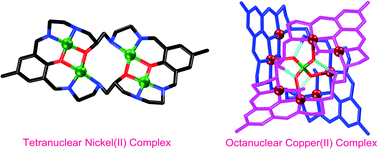By the reaction of an alkoxyl containing tetraamine, 1,3-bis[(2-aminoethyl)amino]-2-propanol, with various aldehydes, O-vanillin and 2,6-diformyl-4-cresol, in the presence of various metal cations, four novel complexes were synthesized and structurally characterized. Complexes [CoHL1](ClO4)·2MeOH (1) and [NiH2L2](ClO4)2·0.5MeOH (2) have mononuclear structures, with the linear di-Schiff base ligand (HL1)2− and mono-Schiff base ligand H2L2 generated from in situ reactions under various pH conditions. In complexes [Ni4L3(SCN)3(MeOH)]Cl·2.5MeOH (3), and [Cu8(H2L3)2(OH)4(ClO4)](SCN)6(ClO4)·8H2O (4), an interesting 32-membered dodecadentate macrocyclic ligand H4L3 comprising four Schiff base C![[double bond, length as m-dash]](https://www.rsc.org/images/entities/char_e001.gif) N double bonds was generated by a “2+2” type condensation reaction between the tetraamine and the dialdehyde. Complex 3 has a tetranuclear Ni4 coordination structure with all 12 coordinating atoms of (L3)4− utilized for coordination, and the alkoxyl groups are deprotonated and coordinated in a bridging mode. Complex 4 exhibits an octanuclear Cu8 coordination structure, with a ClO4− bridging two tetranuclear [Cu4H2L3(OH)2]4+ moieties through four weak axial Cu–O coordination bonds. In complex 4, only 10 coordinating atoms of (L3)4− are utilized for coordination, with the two alkoxyl groups left neutral and noncoordinated. It is noteworthy that H4L3 has two long saturated chains in the molecule. Therefore, it has good flexibility and tends to have a nonplanar structure. Variable temperature magnetic data for 3 and 4 indicated the existence of antiferromagnetic interactions, which were discussed based on the structural results.
N double bonds was generated by a “2+2” type condensation reaction between the tetraamine and the dialdehyde. Complex 3 has a tetranuclear Ni4 coordination structure with all 12 coordinating atoms of (L3)4− utilized for coordination, and the alkoxyl groups are deprotonated and coordinated in a bridging mode. Complex 4 exhibits an octanuclear Cu8 coordination structure, with a ClO4− bridging two tetranuclear [Cu4H2L3(OH)2]4+ moieties through four weak axial Cu–O coordination bonds. In complex 4, only 10 coordinating atoms of (L3)4− are utilized for coordination, with the two alkoxyl groups left neutral and noncoordinated. It is noteworthy that H4L3 has two long saturated chains in the molecule. Therefore, it has good flexibility and tends to have a nonplanar structure. Variable temperature magnetic data for 3 and 4 indicated the existence of antiferromagnetic interactions, which were discussed based on the structural results.
![[double bond, length as m-dash]](https://www.rsc.org/images/entities/char_e001.gif) N double bonds was generated by a “2+2” type condensation reaction between the
N double bonds was generated by a “2+2” type condensation reaction between the 

 Please wait while we load your content...
Please wait while we load your content...